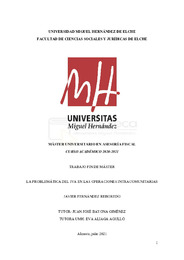Por favor, use este identificador para citar o enlazar este ítem:
https://hdl.handle.net/11000/25477Registro completo de metadatos
| Campo DC | Valor | Lengua/Idioma |
|---|---|---|
| dc.contributor.advisor | Bayona Giménez, Juan José | - |
| dc.contributor.advisor | Aliaga Agulló, Eva | - |
| dc.contributor.author | Fernández Reboredo, Javier | - |
| dc.contributor.other | Departamentos de la UMH::Estudios Económicos y Financieros | es_ES |
| dc.date.accessioned | 2021-11-29T09:57:15Z | - |
| dc.date.available | 2021-11-29T09:57:15Z | - |
| dc.date.created | 2021-07 | - |
| dc.date.issued | 2021-07 | - |
| dc.identifier.uri | http://hdl.handle.net/11000/25477 | - |
| dc.description.abstract | El objetivo de este trabajo es estudiar la problemática que plantea la aplicación del Impuesto sobre el Valor Añadido en las operaciones intracomunitarias en la Unión Europea. Para ello, se analizará en un primer lugar el proceso de implantación del Impuesto dentro de la Unión, hasta el establecimiento del Régimen Transitorio, exponiendo las dificultades que planteaba la introducción de este y analizando las medidas que se llevaron a cabo. Posteriormente, en segundo lugar, se desarrollarán las principales características de funcionamiento de dicho Régimen Transitorio y las debilidades que mostraba, con especial mención al fraude carrusel, que supone un gran problema en la actualidad. Y, por último, en una tercera parte se expondrán las modificaciones que se han implementado hasta el momento con el objeto de atajar el fraude, analizando el grado de efectividad de estas. Finalizando el trabajo con el estudio del futuro Régimen Definitivo del Impuesto basado en el principio de tributación en destino que podrá solventar en gran medida dicho problema. | es_ES |
| dc.description.abstract | The objective of this work is to study the problems posed by the application of the Value Added Tax to intra-UE transactions. To this end, the process of implantation of the Tax within the Union will be analyzed in the first place, until the establishment of the Transitional VAT Regime, exposing the difficulties posed by the introduction of this and analyzing the measures that were carried out. Afterwards, in the second place, the main operating characteristics of this Regime and its weakness it will be described, with a special reference to the carousel fraud, which is a major issue today. Finally, in the third chapter, it will be presented the amendments that have been implemented so far in order to stop this fraud, analyzing their level of effectiveness. Conluding the work with the study of the future Defitivive VAT System based on taxation at origin that it will be able to solve this problem to a large extent. | es_ES |
| dc.format | application/pdf | es_ES |
| dc.format.extent | 90 | es_ES |
| dc.language.iso | spa | es_ES |
| dc.publisher | Universidad Miguel Hernández | es_ES |
| dc.rights | info:eu-repo/semantics/openAccess | es_ES |
| dc.rights.uri | http://creativecommons.org/licenses/by-nc-nd/4.0/ | * |
| dc.subject | IVA | es_ES |
| dc.subject.other | CDU::3 - Ciencias sociales::33 - Economía | es_ES |
| dc.title | La problemática del IVA en las operaciones intracomunitarias | es_ES |
| dc.type | info:eu-repo/semantics/masterThesis | es_ES |

Ver/Abrir:
TFM FERNANDEZ REBOREDO JAVIER.pdf
2,08 MB
Adobe PDF
Compartir:
 La licencia se describe como: Atribución-NonComercial-NoDerivada 4.0 Internacional.
La licencia se describe como: Atribución-NonComercial-NoDerivada 4.0 Internacional.
.png)